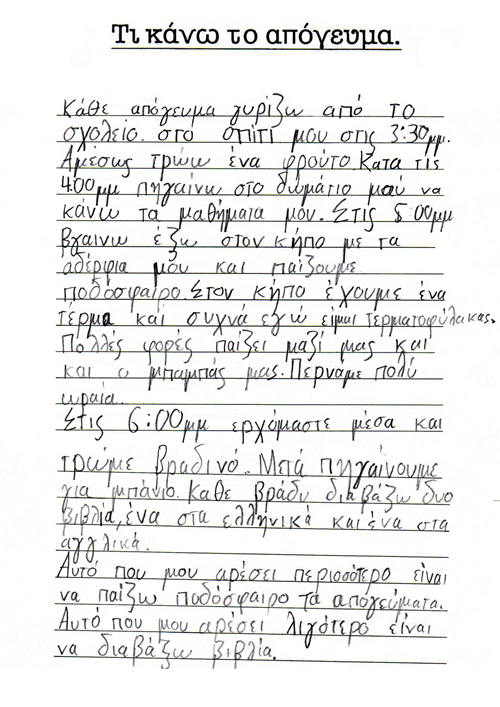Languages: Modern Greek - Satisfactory - Years 7 and 8 (Year 7 entry)
Portfolio summary
This portfolio of student work shows that the student uses Greek to describe feelings, express likes and dislikes and exchange information about their personal world, including information about themselves, their family, friends and interests (WS1, WS2, WS3). The student interacts with others in collaborative and classroom activities, using modelled language to carry out transactions, ask and respond to familiar questions, follow instructions, and seek help or permission (WS1). When interacting, the student pronounces Greek sounds, and uses intonation and accentuation (WS1, WS2). The student obtains information and identifies key points from different sources, using non-verbal and contextual clues to help make meaning. The student describes characters, events and ideas in imaginative texts using high-frequency vocabulary and creates short informative and imaginative texts using modelled sentence structures and formulaic expressions (WS2, WS3). The student uses the present tense, common verbs and other grammatical structures such as verb endings and singular and plural forms to create simple sentences and phrases (WS1, WS2, WS3). The student translates and interprets texts using contextual clues and textual features, and creates simple bilingual texts for classroom use. When interacting, the student modifies their language and behaviour and recognises that aspects of their own language and culture impact on intercultural exchange (WS3).
The student identifies the similarities and differences between the sound systems of Greek and English (WS3). The student describes the key features of common types of texts, comparing them with equivalent text types in English (WS3). The student gives examples of how language varies according to participants, roles and relationships, and context and culture (WS3). The student identifies ways that Greek language and culture have influenced and continue to influence many global languages. The student analyses words and expressions to identify and explain connections between language and culture (WS3).

